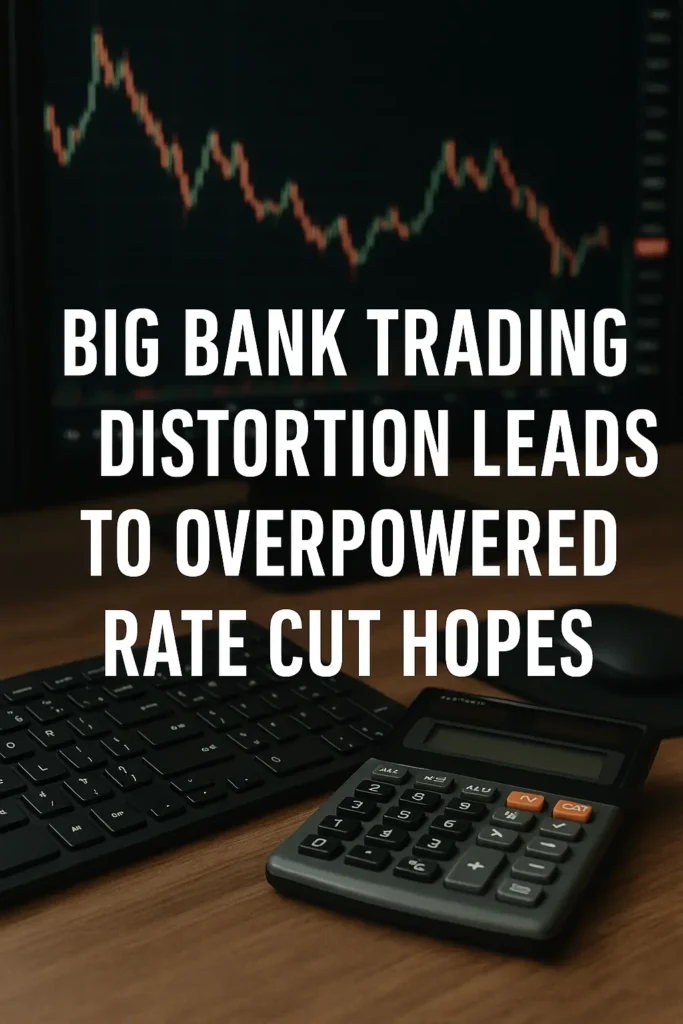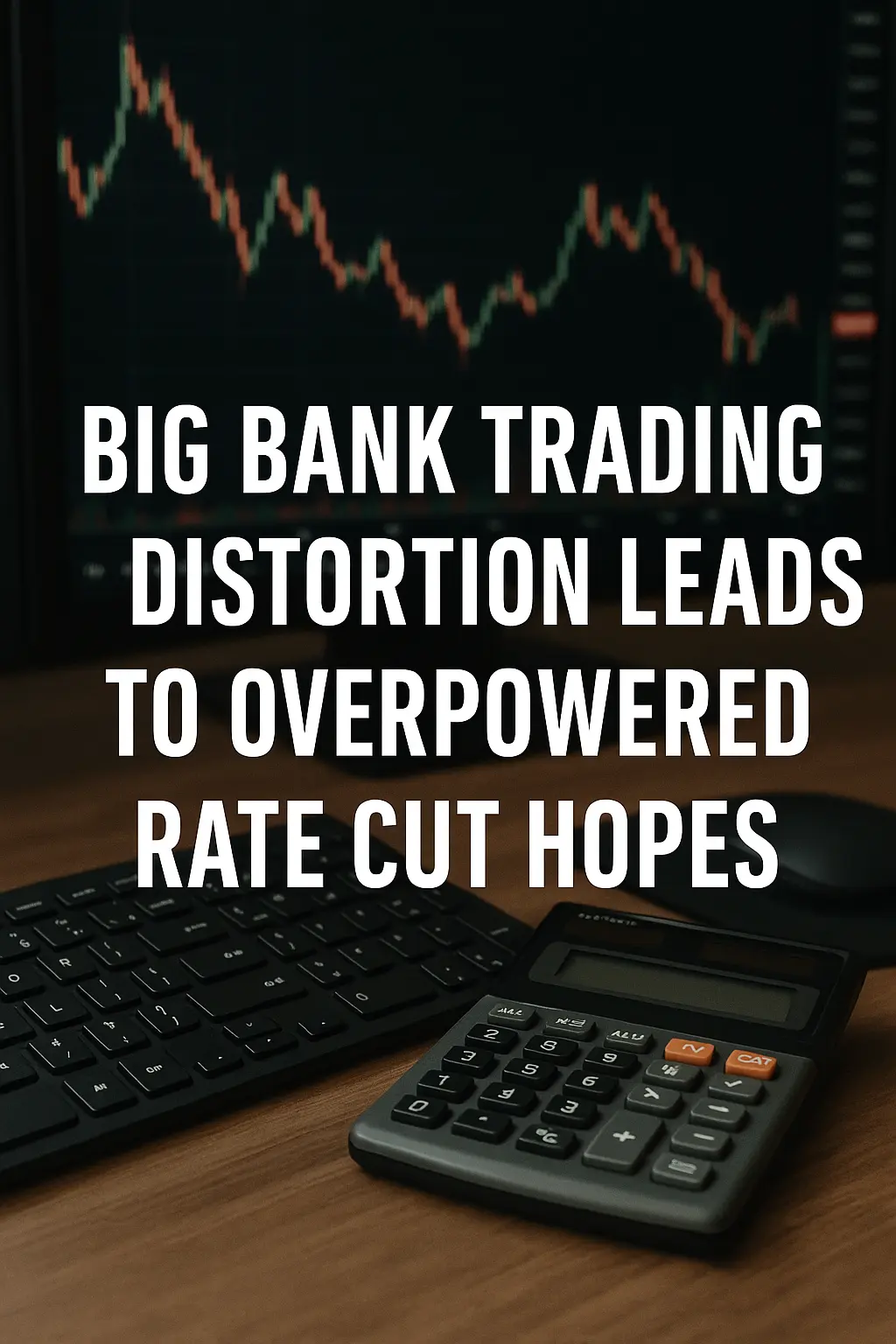Explore how big bank trading activity is distorting market expectations and fueling unrealistic hopes for RBA rate cuts in 2025. Learn what’s really driving the hype, how it impacts Australian investors, and what you should do now.
In recent weeks, headlines across Australia’s financial media have been buzzing with one loud message: Rate cuts are coming. Sooner than expected.
But are they really?
A growing number of analysts, economists, and seasoned investors are now waving a red flag — suggesting that big bank trading desks have distorted market sentiment, leading to unrealistic hopes for aggressive rate cuts by the Reserve Bank of Australia (RBA).
So, what’s really happening behind the scenes?
Let’s break down the hype, the reality, and what Australian savers, borrowers, and everyday investors need to know about this market mirage.
📉 First, What Is a Trading Distortion?
A trading distortion happens when market pricing — particularly in bond yields and interest rate futures — doesn’t accurately reflect the real-world economic outlook.
Instead, it gets skewed by:
- Speculative positioning from big players (like major banks or hedge funds)
- Short-term profit strategies
- Automated trading algorithms that exaggerate market moves
These distortions can create false signals that mislead everyday investors and even professional economists.
💼 Big Banks and Their Quiet Influence on Rate Expectations
The Australian bond market is one of the primary places where future interest rate expectations get priced in.
When traders believe the RBA is going to cut rates, they pile into short-term bonds, driving their yields lower. In theory, this reflects expectations of falling interest rates.
But here’s the twist…
Much of this trading is driven by big banks’ internal strategies, not necessarily because they believe cuts are imminent, but because:
- They’re hedging other investments
- They’re taking advantage of market momentum
- They want to benefit from rate volatility
This creates a feedback loop where media outlets see falling bond yields, assume rate cuts are coming, and report it as such — pushing more retail investors to believe the same.
🧠 The Psychology Behind “Overpowered” Hopes
Why do rate cut hopes escalate so quickly?
1. Wishful Thinking in a High-Cost World
Australians are still dealing with:
- High mortgage repayments
- Expensive groceries
- Rising rents
- Insurance premiums going through the roof
Many households are barely hanging on. So, any whisper of relief — like a potential rate cut — spreads fast and wide. People want it to be true, so they believe it faster.
2. The Market Loves a Rally
Rate cuts often lead to:
- Lower borrowing costs
- Higher stock valuations
- Easier credit conditions
So markets get greedy. The moment there’s a hint of dovish commentary from the RBA or weak economic data, traders jump the gun — pricing in multiple cuts long before they’re likely to happen.
🏦 But What Is the RBA Actually Saying?
If you look beyond the market noise and Twitter speculation, the RBA has remained cautious and non-committal.
Here’s what they’ve clearly stated:
- Inflation is easing but remains above target
- Wage growth is sticky, especially in services
- A tight labour market is still keeping pressure on prices
- The RBA would rather hold higher for longer than cut too soon and see inflation rebound
Translation?
They’re not in a hurry to cut.
In fact, many economists now believe that rate cuts may not arrive until mid-to-late 2025, and possibly even later — especially if wage and services inflation remain sticky.
🔍 Real Data vs. Market Fantasy
Let’s compare what the data shows vs what the market is hoping for.
| Indicator | Current Reality | Market Assumption |
|---|---|---|
| CPI Inflation | 3.6% (still above target) | Falling faster than expected |
| Wage Growth | Rising, especially in services | Will slow down soon |
| Labour Market | Unemployment at ~4.1% | Will loosen more quickly |
| Household Spending | Slowing, but uneven | Sign of demand collapse |
| RBA Messaging | “Not ruling anything in or out” | Dovish pivot is happening |
The gap between reality and speculation is where the distortion lies.
💣 Why This Distortion Is Dangerous for Everyday Australians
It might sound harmless — markets get things wrong all the time, right?
But these distortions can have real-world impacts:
💸 1. Misleading Mortgage Decisions
Borrowers may hold off refinancing or fixing rates, assuming cuts are just around the corner — and end up paying thousands more if cuts are delayed.
💼 2. Poor Investment Timing
Retail investors might pile into rate-sensitive assets (like REITs or tech stocks), expecting a windfall from lower rates — only to see volatility if the RBA holds firm.
📉 3. Market Overreaction Risks
If markets get too far ahead of themselves, the eventual reality check (i.e., when cuts don’t come) can cause sharp corrections — and panic selling.

💬 What Experts Are Saying
Shane Oliver, Chief Economist at AMP Capital:
“Markets are quick to price in cuts at the first sign of weakness, but the RBA is more focused on entrenched inflation. There’s a real disconnect.”
Eliza Owen, Head of Research at CoreLogic:
“Housing affordability is improving slightly, but it’s premature to assume we’re entering a new low-rate environment.”
RBA Governor Michele Bullock (recently):
“While progress is being made, inflation remains too high, and we must be careful not to unwind progress too early.”
Translation? The cuts are coming — but not yet. And certainly not at the pace the market is hoping for.
🔧 What Can You Do as a Smart Investor or Saver?
Here’s how to avoid getting caught up in the hype:
✅ 1. Don’t Chase the Hype
Watch market sentiment, but don’t base your entire financial strategy on rate cut hopes. Make moves based on what’s real, not just what’s possible.
✅ 2. Consider Locking in a Fixed Rate If It Works for You
If you’re a borrower and rates work in your favor today, don’t gamble on future cuts. Certainty beats hope.
✅ 3. Maximise High-Yield Savings Accounts
While rates remain high, take advantage of savings accounts offering 4.5%+ APY. These are risk-free returns — and they won’t last forever.
✅ 4. Diversify Your Investments
Make sure your portfolio isn’t overly tilted toward rate-sensitive assets like growth stocks or REITs. Blend in defensive assets, like:
- Bonds with staggered maturities
- Dividend-paying stocks
- Low-volatility ETFs
✅ 5. Stay Informed, Not Influenced
Follow real economic data, RBA minutes, and official forecasts — not just headlines or social media noise.
🧭 Final Thoughts: Be Wary of Market Myths
Markets aren’t always rational. Sometimes, they’re driven by hope, fear, and noise. And when big bank trading desks move billions based on short-term strategies, the rest of the market often follows blindly.
In 2025, that’s exactly what we’re seeing with Australia’s interest rate cut hype.
So don’t fall for it.
Ask yourself:
“Am I reacting to headlines or responding to actual data?”
That simple question could save you from a bad refinance, a miscalculated investment, or a missed opportunity.
📌 TL;DR – Big Bank Trading Distortion in 2025
- Speculative trading by big banks is warping bond yields
- This distortion fuels unrealistic hopes for RBA rate cuts
- The actual data shows inflation and wages are still sticky
- RBA is in no rush to cut rates — despite market pricing
- Australians should focus on real data, not just sentiment

Related Post
5 Hidden Job Portals Americans Are Secretly Using to Get Hired Fast
